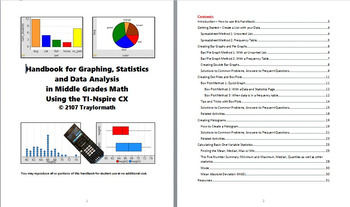Graphing, Statistics & Data Analysis in Middle Grades Using TI-Nspire
- PDF
Description
This 30-page handbook ties together everything you need to use TI-Spire technology to teach middle school level data graphing and statistics. It will show you, step-by-step, how to create bar graphs, pie graphs, dot plot, box plots and histograms, and several methods for finding mean and quartiles, as well as an easy way to calculate Mean Absolute Deviation (MAD) with TI-Nspire. It also answers all those student questions about "why doesn't my graph look right?" Developed though several years of experience with 7th and 8th graders using Nspire CXs to create graphs and analyze data, I hope I've addressed all the possible pitfalls. You can copy all or parts of this handbook for student use.
Please see the Table of Contents for a complete list of topics!
Note: this handbook does not cover scatter plots, regression or two-way tables.





